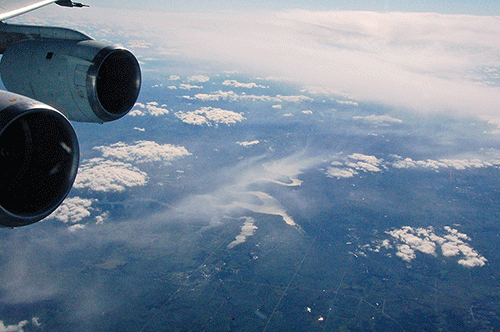Uncovering Earth’s Secrets
The 2015 American Geophysical Union Meeting, held in December, drew nearly 24,000 scientists, policy makers, journalists, and educators to San Francisco. Talks at the conference covered a multitude of topics, including the composition of rocks on Mars and how coastal fog can transport mercury in the ocean to plants and insects on land. In a keynote address, Peter Diamandis, chairman and CEO of XPRIZE, challenged researchers to build an autonomous robot that can map the ocean floor, offering winners of the three-year competition a $4 million grand prize. And those fresh from the Paris climate talks discussed the best ways to inform the public about climate research. Here is a sampling of some of the research we heard described at the meeting.
–Katherine Wright and Jessica Thomas
Wet Eruptions
Every year, two tectonic plates known as the Pacific and the Juan de Fuca move 6 cm further apart. The fault line between the plates, located off the coast of Washington State, shifts frequently, so it’s the perfect place to study tectonic activity. But it’s close to a mile underwater, making real time monitoring tricky. A new ocean floor laboratory, run by the Ocean Observatories Initiative (OOI) and located at one of Juan de Fuca’s active undersea volcanoes—Axial Seamount—aims to change this.
OOI’s “Cabled array” consists of around 140 scientific instruments that surround the volcano and link to land via 900 km of fiber-optic cables. The cables relay seismic data and other signals to scientists in a flash, enabling them to watch the action as it happens. The instruments have already captured an eruption at Axial Seamount. According to John Delaney, a University of Washington scientist involved in the project, the live data from this deep-sea laboratory will soon be publicly available.
Monitoring on a Cloudy Day
Clouds confound most climate models, but they could help researchers map the content at different heights in the atmosphere, according to James Abshire of NASA Goddard Space Flight Center in Maryland. Currently, scientists monitor and other greenhouse gases using a laser technique called lidar. This involves sending a laser pulse from an aircraft or satellite to the ground and analyzing the reflected beam’s spectrum for dips caused by absorption. Lidar gives the average abundance in the entire atmospheric column between the aircraft and the ground. But knowing its abundance in a shorter stretch—particularly within a few thousand meters of Earth’s surface—could help researchers better identify sources and sinks. To get this information, Abshire and his colleagues used shallow cumulus clouds 2000 m above ground as scattering surfaces and compared the lidar signal bounced back from the cloud tops with that scattered back from the ground. Abshire said the method, one of several recently tested for NASA’s ASCENDS mission, can detect concentrations with an accuracy approaching 1 part per million—nearing the level needed for climate models.
Gassy Microbes
Drilling for oil and gas is a dirty business, but not too dirty to support life. Microorganisms are known to thrive in the salty, hot, and high-pressure environments of natural gas wells, but how they got there is a mystery. Kelly Wrighton and colleagues from Ohio State University used genomic tools to study the microbial communities found in wells across the United States. Their analysis suggests that the microbes originate from the surface and were injected during hydraulic fracturing, a process that uses water and other liquids to break apart rocks and release trapped oil and gas. Imaging data indicate that the bacteria settle in the cavities created by the fracturing process. According to Wrighton, the bacteria likely consume chemicals pumped down with the water, and, in some cases, belch out their own methane.
The group is now working to understand how these immigrant organisms can adapt and flourish in such a harsh environment, and whether they contribute a measureable amount of methane to the gas wells.





